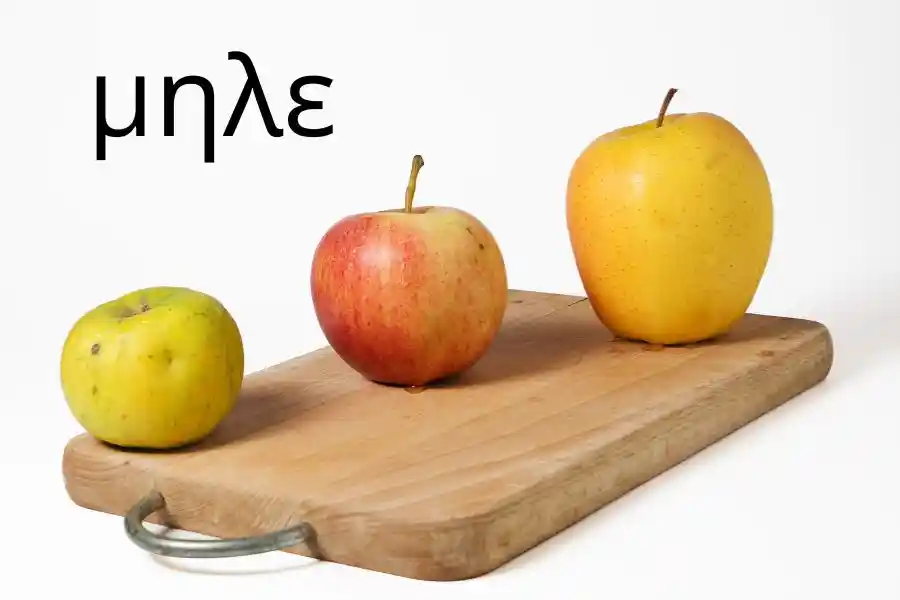μηλε: From Ancient Forests to Modern Kitchens – The Timeless Tale of Apples

Welcome to the extraordinary world of apples, known as “μηλε” in some cultures. This simple fruit, familiar and beloved, carries a profound legacy intertwined with history, culture, health, and culinary delights. From ancient forests to modern kitchens, apples have carved out a significant place in human civilization, symbolizing knowledge, beauty, and sustenance.
In this detailed exploration, we delve into the diverse facets of apples, shedding light on their history, varieties, nutritional benefits, culinary uses, cultural significance, and more. This journey will reveal the intricate layers of one of the most cherished fruits on the planet, proving that apples are much more than they appear to be.
The History and Evolution of Apples
The story of apples dates back thousands of years, with roots stretching to the wild forests of Central Asia, particularly around present-day Kazakhstan. The apple tree, scientifically known as Malus domestica, has undergone significant transformations through centuries of cultivation and breeding.
Ancient Beginnings
Archaeological evidence suggests that humans have enjoyed apples since at least 6500 B.C. Trade routes and the movements of nomadic tribes facilitated the initial spread of apples from Asia to Europe and the Mediterranean. The Greeks and Romans were instrumental in recognizing the utility of apples, enhancing their cultivation techniques, and documenting various aspects of apple farming in their agricultural writings.
Middle Ages to the New World
By the Middle Ages, apples had become a dietary staple in Europe. Monasteries played a vital role in propagating different apple varieties, with monks experimenting with grafting to produce consumable and enjoyable fruit. This period marked the beginning of organized apple orchards.
The exploration of the New World brought apples to America.
The first apple orchard in North America was planted in Boston in 1625. European settlers introduced their apple varieties, significantly altering the agricultural landscape. Johnny Appleseed (John Chapman) became a folk hero for his efforts to plant apple trees across the United States, promoting the spread of apple cultivation.
Modern Era
In the 20th century, we witnessed a revolution in apple breeding techniques, leading to numerous new varieties. Innovations in storage and transportation have enabled apples to be available year-round, transcending seasonal limitations. Today, apples are crucial in global agriculture, dietary habits, and cultural traditions.
Varieties and Types of Apples
Apples are renowned for their remarkable diversity, with over 7,500 varieties grown worldwide. Each type boasts unique flavours, colours, and textures, catering to various uses and personal preferences.
Common Varieties
Red Delicious: Known for its sweet taste and crisp texture, it is a popular choice for fresh eating.
Granny Smith: Vibrant green with a tart flavor, ideal for baking due to its firmness.
Fuji: Originating from Japan, it is loved for its super sweet flavor and dense flesh, which is perfect for snacking.
Gala: Mildly sweet with pleasant crispness, versatile for eating raw and cooking.
Exotic and Lesser-Known Types
Bramley: Predominantly grown in the U.K., it is celebrated as one of the best cooking apples due to its sharp flavor and fluffy texture.
Honeycrisp: Developed in Minnesota, it gained popularity for its exceptional crispness and balanced sweetness, which makes it ideal for fresh eating.
Special Attributes
Some apple varieties are developed to enhance specific attributes, such as increased sweetness, reduced browning when cut, or extended shelf life. For instance, Arctic apples are genetically modified to resist browning, maintaining their aesthetic appeal longer than natural variants.
Geographic Influence
Climate and soil type significantly influence apple characteristics. Apples grown in cooler climates tend to have a crisper texture and more balanced acidity, while those from warmer regions often produce softer and sweeter fruits.
Nutritional Profile of Apples
Apples are celebrated not only for their taste but also for their impressive nutritional benefits. They offer a wealth of vitamins, minerals, and other beneficial compounds that contribute to a healthy diet.
Vitamins and Minerals
Apples are rich in vitamin C, a powerful antioxidant that helps protect the body against free radicals and supports the immune system. They also provide a decent amount of vitamin K, which is essential for blood clotting and bone health. B vitamins, including riboflavin, thiamine, and vitamin B6, are present in modest amounts crucial for energy metabolism. Additionally, apples offer potassium, which is vital for cell function, heart health, and maintaining normal blood pressure.
Dietary Fibre
A medium-sized apple contains about 4 grams of fibre, approximately 16% of the recommended daily intake. Dietary fibre aids digestion, promotes regular bowel movements, lowers cholesterol levels, and helps with weight management by providing a feeling of fullness.
Phytonutrients
Apples are loaded with polyphenols and plant compounds with antioxidant properties. These antioxidants, such as quercetin, are known for their anti-inflammatory effects and potential to reduce the risk of cancer, heart disease, and diabetes.
Antioxidant Effects
The antioxidants in apples contribute to skin health and cell protection, combating early signs of ageing and promoting hair health. They help inhibit the oxidation of body cells, playing a role in preventing tissue damage.
Low in Calories
A medium-sized apple contains about 95 calories. Their low-calorie and high-fiber content makes apples an excellent snack for weight management and hunger control without compromising nutritional intake.
Culinary Uses of Apples
Apples are incredibly versatile in the kitchen, suitable for a wide range of sweet and savory dishes. Their unique flavours and textures make them ideal for various recipes, from breakfast to dessert.
Baking with Apples
Apple pies and crumbles are quintessential desserts showcasing the fruit’s ability to harmonize with spices like cinnamon and nutmeg. Apples hold up well when baked, providing a satisfying texture in cakes, muffins, and breads.
Cooking with Apples
Apples enhance savoury dishes, adding a crisp, fresh element to salads or being cooked into sauces and chutneys that complement meats like pork and chicken. Their acidity and sweetness blend well with hearty meats, adding depth to the flavours.
Apple-Based Beverages
Fresh apple juice and cider are popular beverages, especially in the fall. For a comforting winter drink, apple cider can be enjoyed cold or heated with spices. Hard cider offers a fermented, alcoholic twist, varying from sweet to dry.
Raw Uses
Sliced apples make great snacks, either on their own or with peanut butter, cheese, or caramel dip. Raw apples retain all nutrients, providing a refreshing, healthy snack option.
Innovative Culinary Creations:
Chefs and home cooks experiment with apples in innovative ways. Apple slices add a sweet crunch to grilled cheese sandwiches, while diced apples bring a touch of sweetness to stir-fries. Apple butter serves as a spread for toast, a topping for pancakes, or a sweet addition to oatmeal.
Apples in Cultural Traditions and Symbolism
Apples are deeply woven into many cultures, carrying symbolic meanings and playing central roles in various traditions and folklore.
Symbolism in Mythology
In Greek mythology, apples symbolize beauty and desire, prominently in the story of the golden apple of discord. Norse legends regard apples as symbols of eternal youth believed to keep the gods young. In many cultures, apples represent knowledge and enlightenment, as depicted in the biblical story of Adam and Eve.
Apples in Literature and Popular Media
Apples often symbolize knowledge, beauty, or sin in literature and films. In the fairytale of Snow White, the apple represents deception and hidden dangers.
Apples in Festivals and Celebrations
Apple festivals are celebrated worldwide, featuring apple picking, pie contests, and cider tasting. In Japan, the apple blossom is celebrated for its fleeting beauty during spring, similar to the cherry blossom.
Cultural Practices and Beliefs
In some cultures, apples are used in divination practices during Halloween and the Chinese New Year. In Jewish tradition, apples dipped in honey during Rosh Hashanah symbolize a sweet new year.
Alternative Uses for Apples
Apples serve many uses beyond dietary benefits, from beauty treatments to household solutions.
Beauty and Skincare
Apples contain acids and vitamins beneficial for the skin. Apple cider vinegar is popular in skincare routines because it balances the skin’s pH, reduces acne, and soothes sunburns. Apple pulp can be used as a gentle exfoliator, and the antioxidants in apples help reduce wrinkles and preserve a youthful glow.
Health Remedies
Apple cider vinegar aids digestion, boosts immune function, and promotes weight loss. The pectin in apples helps absorb toxins in the colon, which benefits intestinal health.
Household Uses
Apples can act as natural air fresheners when simmered with spices. Apple cider vinegar is an effective cleaning agent for cleaning windows, disinfecting surfaces, and polishing metal. It can also help control pests in the garden.
Creative Crafts
Apple peels and cores can be dried to create potpourri or decorative items. During autumn, dried apple slices can be strung into garlands or added to wreaths for seasonal decorations.
Growing and Harvesting Techniques for Apples
Growing apples involves careful cultivation techniques to produce healthy trees and high-quality fruit.
Cultivation Conditions
Apples thrive in temperate climates with distinct seasons. They require a period of cold dormancy, known as chill hours, to break bud and commence spring growth. Well-drained, loamy soil with a slightly acidic to neutral pH is ideal.
Planting Techniques
Apple trees are typically planted in late fall or early spring. Grafting is common, with most apple trees grown on rootstocks that control tree size and enhance disease resistance.
Maintenance Practices
Regular pruning is crucial to shape the tree, remove dead or diseased wood, and ensure adequate sunlight penetration. Thinning fruit is important to prevent overloading branches and improve fruit quality.
Pest and Disease Management
Common pests include codling moths, aphids, and apple maggots. Diseases like apple scab, fire blight, and powdery mildew can affect trees. Integrated pest management practices, including biological controls, proper sanitation, and selective pesticide use, are essential.
Harvesting Methods
Apples are typically harvested by hand to avoid bruising. The harvest timing is critical; apples picked too early may not ripen properly, while those left too long may become mealy. Different varieties mature at other times, from late summer to late fall.
Environmental Impact and Sustainability of Apple Production
Sustainable apple production practices aim to minimize environmental impact and promote long-term agricultural health.
Environmental Considerations
Apple orchards provide habitat for wildlife and contribute to biodiversity. However, conventional apple farming can involve significant pesticide use, impacting soil and water quality.
Sustainable Practices
Organic Farming: Avoids synthetic pesticides and fertilizers, uses natural alternatives, and promotes soil health.
Integrated Pest Management (IPM): Combines biological, cultural, and mechanical methods to control pests with minimal environmental impact.
Agroforestry: Integrating apple trees with other crops and livestock to enhance biodiversity and ecosystem services.
Water Conservation: Implementing efficient irrigation techniques, such as drip irrigation, to reduce water use.
Certification Programs
Certification programs like USDA Organic and Fair Trade promote sustainable practices and ensure farmers receive fair compensation. Participating in these programs can improve market access and consumer trust.
Future Trends and Innovations in Apple Cultivation
Advancements in apple cultivation continue to evolve, driven by scientific research and technological innovations.
Genetic Research:
Genetic research aims to develop apple varieties with improved disease resistance, climate adaptability, and enhanced nutritional profiles. CRISPR technology is being explored for precise genetic modifications.
Precision Agriculture
Precision agriculture uses drones, sensors, and GPS mapping to monitor crop health, optimize inputs, and increase efficiency. This approach reduces waste and environmental impact while maximizing yields.
Climate Change Adaptation
As climate change affects growing conditions, researchers are developing apple varieties that can withstand higher temperatures, drought, and extreme weather events. Breeding programs focus on traits like heat tolerance and disease resistance.
Vertical Farming
Vertical farming and urban agriculture offer innovative solutions for growing apples in controlled environments, reducing the need for arable land and minimizing transportation emissions.
Consumer Trends
Consumers increasingly seek sustainably grown, locally sourced apples with unique flavours and health benefits. Marketing strategies emphasize transparency, sustainability, and connection to local communities.
Conclusion About μηλε
Apples as μηλε, simple yet extraordinary, continue to captivate us with their rich history, diverse varieties, and numerous benefits. Whether enjoyed fresh from the tree, baked into a pie, or crafted into cider, apples offer a sensory and nutritional delight. Their journey from ancient forests to modern tables showcases their enduring appeal and significance. You can also know about Vyvymanga by going through that link.





